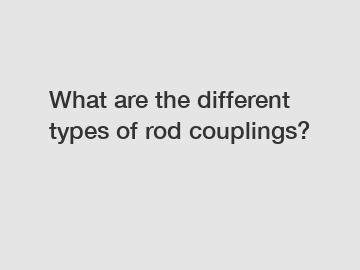What are the different types of rod couplings?
Rod couplings are crucial components used to connect two threaded rods together, creating a strong and reliable joint. They are commonly employed in a wide range of applications, such as construction, manufacturing, plumbing, and automotive industries. Understanding the different types of rod couplings can help in selecting the most appropriate option for specific purposes. In this article, we will explore four common types of rod couplings – sleeve couplings, union couplings, compression couplings, and bolted couplings.
1. Sleeve Couplings:

Sleeve couplings, also known as straight or tight couplings, are one of the simplest and most straightforward types of rod couplings. These couplings consist of a cylindrical sleeve with internal threads at both ends. By inserting the threaded rods into the sleeve and tightening the nuts on each side, a secure connection is achieved. Sleeve couplings are suitable for low to medium load applications where alignment is not a significant concern. They are quick and easy to assemble, making them widely used in everyday projects.
2. Union Couplings:
Union couplings, also referred to as box couplings, connect two rods of equal diameter in a flush manner. These couplings feature a central box-like component with internal threads that match the rods' dimensions. Union couplings provide a strong connection and allow for easy disassembly, making them ideal for applications that require periodic maintenance or repair. Additionally, their flush design makes them useful in situations where a smooth, streamlined connection is desired.
3. Compression Couplings:
Compression couplings, as the name suggests, achieve a secure joint through compression. These couplings consist of two parts – a sleeve with internal threads and multiple compression fittings. By inserting the threaded rods into the sleeve and tightening the compression fittings, the rods are squeezed tightly together, creating a robust connection. Compression couplings are frequently used in industries where vibration, shock, or constant movement occurs, as they offer excellent resistance to loosening and misalignment.
4. Bolted Couplings:
Bolted couplings, often called clamp couplings, are a versatile type of rod coupling that can handle heavy loads and provide excellent joint rigidity. These couplings include a metal clamp or collar that encircles the rods, along with bolts that pass through the clamp and secure the rods in place. Bolted couplings offer easy installation and allow for precise adjustment, making them suitable for applications requiring precise alignment. They are commonly found in large-scale industrial projects, infrastructure construction, and heavy machinery.
In conclusion, selecting the appropriate type of rod coupling is crucial for achieving a strong and reliable connection between threaded rods. Sleeve couplings are simple and quick to assemble, making them suitable for low to medium load applications. Union couplings are useful for situations that require periodic maintenance or repair, while compression couplings offer excellent resistance to vibration and movement. Lastly, bolted couplings provide high load capacity and precise alignment adjustment, making them ideal for heavy-duty applications. By understanding the characteristics and applications of these four types of rod couplings - sleeve, union, compression, and bolted - one can make informed decisions and ensure the success of their projects.
If you want to learn more, please visit our website f-1000 triplex mud pumps, solids control jet mud mixing pump supplier, api-7k triplex mud pumps custom.



Comments
Please Join Us to post.
0